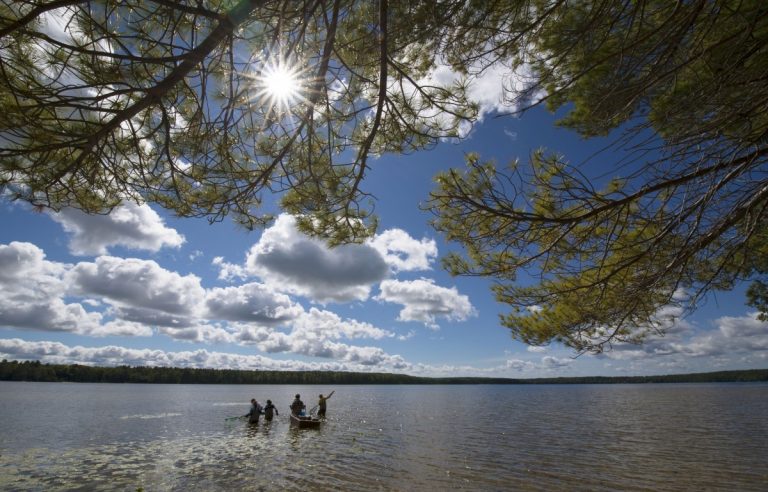
Michigan boasts an impressive 36 million acres of land, including 11,000 inland lakes, 36,000 miles of rivers and streams, and 20 million acres of forest – making it one of the most forested regions across the United States. Michigan is home to three national forests; seven national parks, heritage areas and trails; two large national wildlife refuges; and the 60,000-acre Sleeping Bear Dunes Wildness State Park; plus countless other nature reserves.
Find out more about studying at University of Michigan, School for Environment and Sustainability.
The name Michigan derives from the Ojibwa word ‘mishigamaa’, which means ‘large lake’, referencing four of the state’s five Great Lakes that were carved by glaciers more than 12,000 years ago. The Great Lakes regions are the planet’s largest bodies of freshwater, and are also clearly recognizable from space. The Great Lakes are so big that they can significantly impact Michigan’s weather activity, creating favourable environments for the range of agricultural products that grow throughout the region. Thanks to the Lakes, Michigan is a leader in the growth of several crops, including blueberries, cherries, asparagus, and grapes for juice and wine.
Such natural landscapes are invaluable to students wishing to pursue a career in Environmental studies. Wildlife thrives here, gifting students with the chance to examine animals in their natural habitat and discover how they use their surroundings to survive. An abundance of research and study opportunities provide students with the chance to explore the various fields of Environmental study before deciding which particular field to specialise in.

The School for Environment and Sustainability at the University of Michigan makes the best use of the living laboratory that is Michigan for students. In terms of reputation, the University of Michigan is currently ranked the number one public research institution in the United States, also coming in number six for students studying abroad, and number 12 for the most LGBTQ-friendly campus.
The University has a number of off-campus field research sites, powered by a mission to protect the Earth’s resources and achieve the ultimate sustainable society.
“Through research, teaching and outreach, faculty, staff and students are devoted to generating knowledge and developing policies, techniques and skills to help practitioners manage and conserve natural and environmental resources to meet the full range of human needs on a sustainable basis,” the school’s mission discourse states.

Michigan’s Master of Science programs offer students a common foundation in ecological science, environmental governance, and integrated assessment via three core courses, before offering the chance to specialise in one or more of the following fields of study: Behavior, Education and Communication, Conservation Ecology, Environmental Informatics, Environmental Justice, Environmental Policy and Planning, and Sustainable Systems.
A defining feature of the SEAS master’s program is its interdisciplinary focus; an aim that extends to the pursuit of a dual degree. Each natural resources and environment field of study provides the perfect foundation for a dual degree, with students choosing disciplines from the following fields of study: Engineering, Business, Urban and Regional Planning, and Law.
For those wishing to follow a Doctor of Philosophy path, the program offers two primary tracks: Resource Ecology Management, which has a particular focus on natural sciences; and Resource Policy and Behavior, which focuses more on the social sciences. Students may choose a highly-specialized course of study, or one that broadly addresses complex and interdisciplinary issues that are affecting the global environmental system.

The aim of the doctoral program is to harness the creative abilities of students, preparing them for independent work that contributes to original research and scholarship in their chosen fields. Graduates of the program will be leaders in research, teaching and training others – developing the scientific knowledge base needed to formulate policies and practices that help sustain the natural resources on our planet.
Commenting on his experience at SEAS, John Andreoni, a 2017 graduate, describes the learning environment as a “community of people with such diverse backgrounds and approaches to a common goal of living harmoniously with planet Earth”.
The pursuit of Environmental studies opens the door to a range of paths for life after university. Local heritage sites and nature reserves, government agencies, global organizations, research institutes and broadcast companies are among those who actively seek out Environmental graduates. The critical thinking and analytical skillset developed whilst learning such a hands-on subject are greatly desired across all types of industry.
Follow Michigan’s School for Environment and Sustainability on Facebook, Twitter, YouTube, Instagram and LinkedIn
Liked this? Then you’ll love these…
Universities that produce the next generation of Environmental advocates







